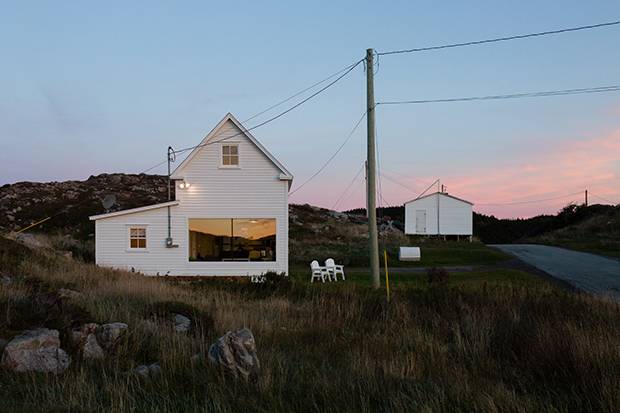Janet Denstedt and Richard Wharton acquired their first saltbox home in the community of Fogo in 2009. The couple, who were Ontario-based at the time, were on the island, off Newfoundland's northern coast, looking to purchase a vacation property. During a lunch visit to a local restaurant, Wharton started speaking to one of the eatery's employees who mentioned that her family might have a home for sale.
"They were living in this saltbox house, and they decided to build a new house," says Wharton. "They built a traditional bungalow right next door and got to a certain point that they couldn't really afford to do anymore until they got rid of the house they were in. So she said to us, 'Well, I'll sell you my house, but you have to take it away.' And we said. 'That's great, we could do that. But we have no land.' And so she said, 'Oh, well, I'll sell you this piece of land.'"
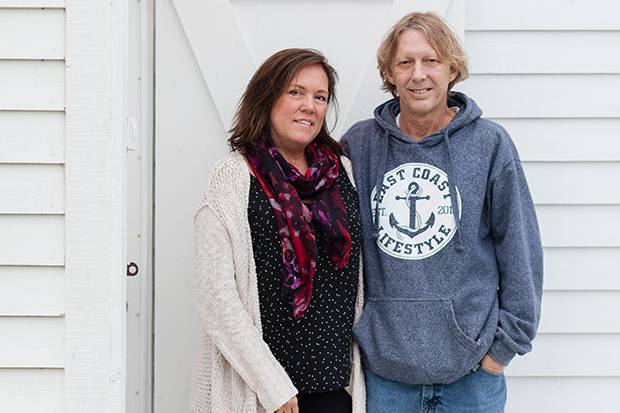
Janet Denstedt and Richard Wharton have built a vacation-rental business around Newfoundland saltbox houses they’ve renovated.
While they were renovating their first saltbox, a neighbour down the street mentioned that she, too, had a house she wanted to divest herself of. "So we actually picked hers up and moved it over onto the same piece of property," Wharton says. Shortly after that, they acquired a third saltbox property and then decided to formally create a chain of holiday rentals dotting Newfoundland's coast under the name the Old Saltbox Co. They now have three on
Fogo Island, three in the Twillingate area, one in the remote community of Greenspond and one in Musgrave Harbour. In the fall of 2017, they opened their ninth and 10th houses on the south coast in the communities of Burgeo and Francois. The properties are open all year round and some are already fully booked for the coming summer.
When you come from away – that is anywhere outside of Newfoundland and Labrador – saltbox homes are striking in their simplicity, perched atop craggy rocks on the ocean's edge. For locals, the homes are steeped in tradition and tell a part of the province's settlement history. The saltbox design developed over generations on the island, spanning from 1835 to 1960. Constructed primarily of wood because there was a ready supply of it, and typically one or one and a half storeys tall, their dramatic sloping roof gives the impression that the house is bigger than it actually is and allows for lean-tos to be added to the initial structure. The name "saltbox" was adopted because the homes echoed the shape of the wooden lidded boxes that salt was stored in at the time.
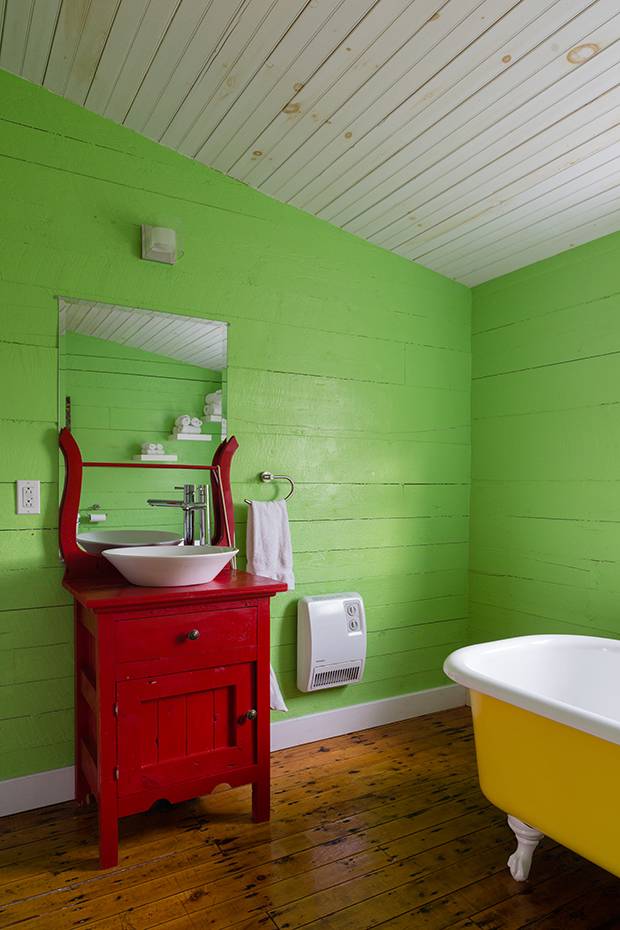
Each home follows a colour theme, with walls, furniture and accents in yellows, greens, purples and teals.
Over the decades, "modern building materials started to change the structure [of these homes], but the basic form and pattern were maintained – a central hall and rooms on both sides," says Jerry Dick, executive director for Heritage Newfoundland and Labrador, which promotes the province's built and intangible cultural history.
Denstedt and Wharton have further adapted the design by adding a dramatic picture window facing the water to most of their properties. Each home is bought with the view from the picture window in mind, a front seat for the wildest moods of Mother Nature as she has her way with the Atlantic Ocean. If a visit is timed right, some offer the opportunity to see icebergs from the living-room couch.
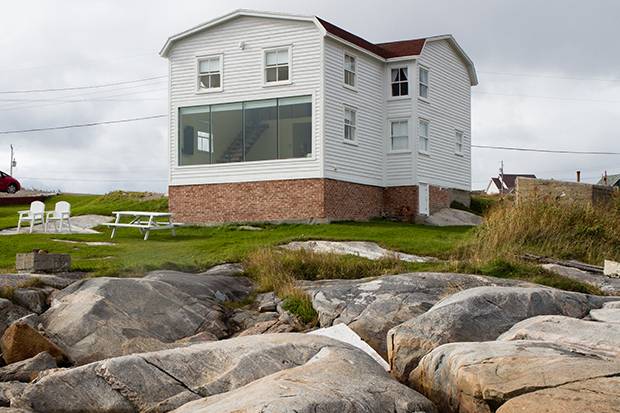
Colour and panoramic picture windows both play a big part in the design of each home.
The Old Saltbox Co.'s remodelling and renovation process varies depending on the state of the original structure. "Whatever we can keep that's worthwhile and that looks old, we do. But we completely rewire, re-insulate, and add new windows, new roof," Wharton says. In some cases, a
two-storey home with low ceilings has become a spacious one-floor structure with a vaulted ceiling.
The interior design of each house was inspired by that first home on Fogo, which operates under the name Grandma Lilly's. (The houses, with names like Aunt Donna's, Mary's Place and Aunt Glady's, are each named after important women in Denstedt's and Wharton's lives: grandmothers, mothers, aunts.)
Wharton, who oversees the architectural design and construction, tries to preserve as much as the original structure as possible. When he can't, the couple tracks down local craftspeople who create heritage-inspired pieces. "Richard has a guy that will just mill us the wood in the shapes we want," says Denstedt. "You'll notice, this wall, all the boards are different widths, because that's what they did years ago. So we'll still keep up that same look – replace a wall with all different wood so that it's like the authentic wood."
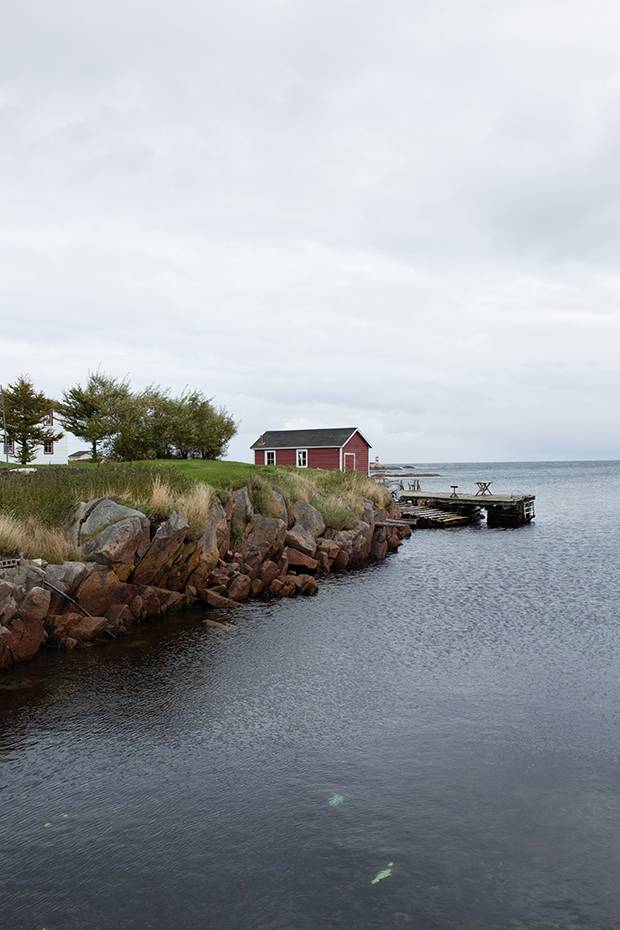
For locals, the homes are steeped in tradition and tell a part of the province’s settlement history.
Though the small single-pane windows are new, they are designed as they would have been in saltbox homes from the last century. "They're handmade by a local guy on
Fogo, but they're made like the old windows. So they get the draft, just like the old windows," says Denstedt. Lest one think air coming through the frames is an architectural flaw, Chris Woodford, a principal at the St. John's-based architecture firm Woodford Sheppard, says the breeze can be beneficial. "One of the reasons why wood-framed buildings from over a hundred years ago still stand is because they were allowed to breathe," he says.
In the event of a draft and to keep guests warm at night, Denstedt commissions original quilts from the Fogo Island Anglican Church Women's Group. "Everybody here on Fogo Island tends to enjoy advertising ourselves – we like to let people know that this is who we are and we're proud of it," says Daphne Payne, the group's leader. "Every one of the quilts is hand embroidered and machine sewn. It's a wonderful tradition and we love to do it. A lot of foreigners come and stay in those houses because they are traditional Newfoundland houses. And they get to know us through those quilts."
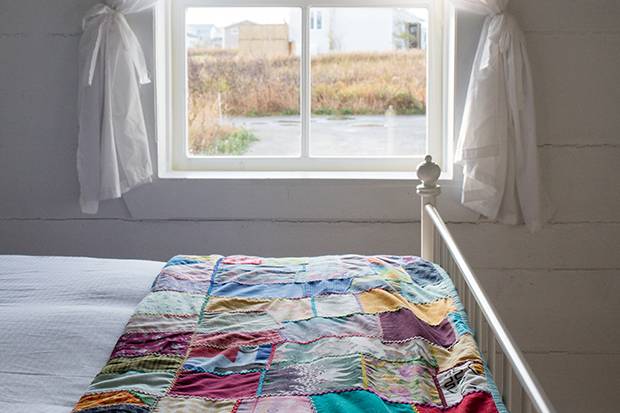
Quilts created by the Fogo Island Anglican Church Women’s Group top most beds and many guests seek out their own to take home as a souvenir.
For the rest of the decor, each home follows a colour theme, with walls, furniture and accents in yellows, greens, purples and teals.
Denstedt also incorporates pieces that have connections to the local community, such as hanging a fishing net as art, or framing old newspaper clippings found pre-renovation, as she has done at Aunt Christi's in Greenspond.
The majority of guests booking stays with the Old Saltbox Co. are locals and travellers from Ontario, with an increasing number from western Canada and the United States. Denstedt says she's received more bookings from European visitors, too.
"The traditional saltbox home is such an iconic image on the island, which has become synonymous with living here," says Woodford. "One of the greatest strengths of the traditional housing form is its simplicity and its adaptability."
"If done correctly you get architecture that is not only rooted in the history of our island, but also helps us transition into the future," he adds. "The real challenge is finding this balance."
Maryam Siddiqi travelled to Newfoundland as a guest of Adventure Central Newfoundland. The company did not review or approve this article prior to publication.
On location
The Old Salt Box Co.
Accommodations range from single-bedroom homes to three-bedroom options that can be rented by the night or week. Off-season rates are available from mid-October until May 1. In-season rates start at $175/night. theoldsaltboxco.com.
Visit tgam.ca/newsletters to sign up for the Globe Style e-newsletter, your weekly digital guide to the players and trends influencing fashion, design and entertaining, plus shopping tips and inspiration for living well. And follow Globe Style on Instagram @globestyle.
